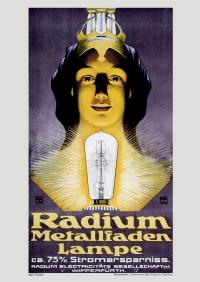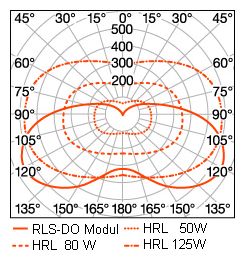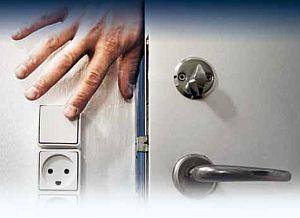Energy efficiency of lamps, luminaires and systems ![Madonna]()
The more light is generated by a lamp of a certain wattage, the more efficient this lamp will be.
Economic lighting means that enough light is provided at the time an place, but only, when it is needed.
In many cases, this can be realised by employing an intelligent light management system only.
Luminous efficiency – rating the energy efficiency of lamps
The luminous efficiency in lm/W is, therefore, a measure for the efficiency of all lamps: from about 150 lm/W a lamp could be taken as highly efficient.
As lamp luminous efficiency, it will be quoted just for the lamp itself. The system luminous efficiency should include all needed control gear for the lighting system altogether (if known).
For lamps - from 2021 light sources - for end users, the efficiency can be assessed using the energy label (see below for details).
System luminous efficiency – effects of different operational gear
Operational devices do also consume energy, generate greenhouse gases and costs and, therefore, are affected by energy saving regulations (see ErP, for example).
In principle, control gear can be classified like this:
- Conventional ballasts CCG:
These transformers or chokes are robust with long service life, on the one hand, but they also do have high power losses. If there are technologically sensible alternatives, CCG are not to be used in new installations any more.
- Low-loss conventional ballasts LLCG:
For some applications electronic control simply cannot be employed. In this case, especially efficient and high grade conventional ballasts (chokes) must be used.
- Electronic ballasts ECG:
ECGs are clearly more efficient than conventional control gear as the built-in circuits have less material and mass and some lamp types like fluorescent lamps have got less input-power. Their service life, however, may be limited due to the kind of parts used (instant start or warm start ballast) or the ambient conditions (like temperature, humidity). For or maybe better in LED-lamps almost exclusively electronic drivers are employed.
- Starters:
Safety starters must be changed with every 4th lamp change, only. So, they need less material and energy being produced.
- Ignitors, Hot restrike ignitors:
A hot restrike ignitor must be on stand-by during the whole lamp operation time, therefore, it consumes energy, whereas other ignitors can switch off. Warm start ECGs for fluorescent lamps with cut-off technology switch off the filament electrode heating, so, they save energy and make their service life longer.
Energy efficiency of luminaires ![LVK RLS-DO Modul]()
Target: high illumination efficiency
High illumination efficiency can be achieved by a light room decoration, positioning of the luminaires according to the intended purpose of the application and, most of all, by a high operational efficiency of the luminaires. Efficient reflector technology, siutable optics and maintenance friendly designs with low affinity to dirt, for example, by using a luminaire with higher protection (min. IP 5x) may have less light losses in the course of time. Therefore, less energy will be consumed in the end and the maintenance intervals may even be made longer.
Waht is illumination efficiency?
The illuminance within the application is measured and put into proportion with the sum of luminous fluxes of all employed lamps. The illumination efficiency mainly depends on the distribution of luminous intensities of the luminaire (directly – indirectly), with indirect lighting it also depends on the reflection properties of the room.
How is the operational efficiency of luminaires determined?
In standard conditions, there will be measured which percentage of original lamp luminous flux still comes out of the luminaire.
It is determined by the kind of beam control (reflectors) and also by the thermal conditions in the luminaire.
Energy label = Energy classification for lamps / light sources
(acc. to directive EU 874/2012 until 31st Aug 2021; NEW EU 2019/2015 from 1st Sept 2021)
Lamps - or light sources, respectively - for end users / consumers must show the energy label on their packaging.
At the point of sale - meaning the shelf in the shop - there even must be put up a coloured tag with the EAN of the lamp regarded.
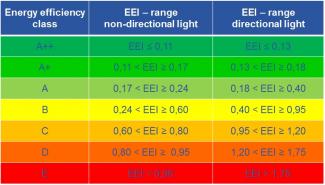
Depending on the light technology, an index will be calculated with complex formulae and this determines then the energy efficiency class - the so-called energy label - which can be taken out of tables in the directive.

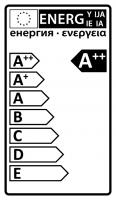
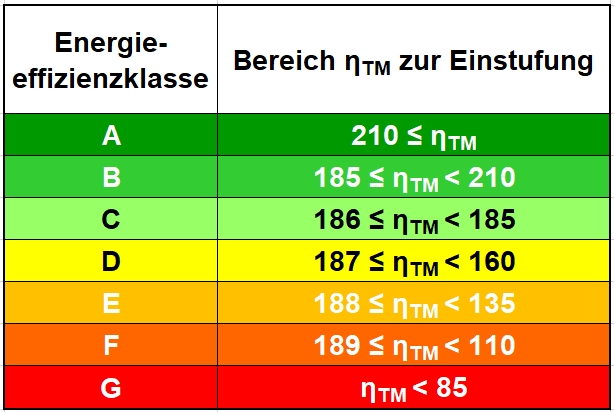
Depending on the type of light source, the mains voltage luminous efficacy ηTM is calculated using a formula and the energy efficiency class - called the "energy label" - is read from the table.
The light technology (type of light generation) does not play a role any longer.


Energy efficient operation ![Hand_am_Schalter]()
When the overall efficiency of a lighting installation should be increased noticeably, then besides efficient operational gear, technology for operation as and when required may be employed such as presence control or power reduction. These, however, need exact planning, as fault free function can only be guaranteed if operation and gear (dimmer, motion detector) have been toned in exactly with the lamp technology in use. Furthermore, the functionalities and possibilities of intervention could decide over the acceptance of the whole system.
The best known system in this respect is daylight control with presence detection which needs dimmable and controllable ECGs. Thus, illumination within the room and also during the day can be kept about constant. The extension by adjustment of the light colour to the time of day can ensure a pleasant and productive indoor climate in the implementation of the Human Centric Lighting concept (HCL). Moreover, some different combinations of technologies can be employed (not for all lamp types!) like motion detection, time switches, dimming or half-light by night.
Choice of a suitable system
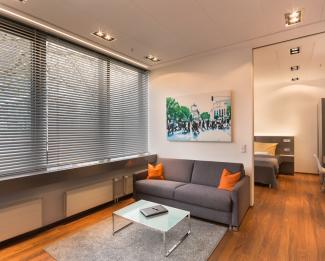 Purpose of application, conditions of the room and further requirements, e.g. emotional or health (circadian rhythm, colour sequences, constant light etc.), costs, maintenance characteristics and so on must be considered when planning a lighting installation sensibly.
Purpose of application, conditions of the room and further requirements, e.g. emotional or health (circadian rhythm, colour sequences, constant light etc.), costs, maintenance characteristics and so on must be considered when planning a lighting installation sensibly.
According to that, technologies and components can be chosen.
- With lamps or light sources it not just brightness one needs to focus on, but the art is to find the right compromise between luminous efficiency and colour rendering.
- For luminaires light distribution curve, temperature considerations, mounting and maintenance such as emergency lighting have to be kept in mind.
The chosen light sources - lamps/ light sources and luminaires/ fixtures - and the known room parameters then can go into the planning process which can be accomplished with certain software (for example Dialux, Relux, Luxoworks,...) . The results will be depicted in numbers, as graphics and - depending on the kind of software - even photo-realistic.

